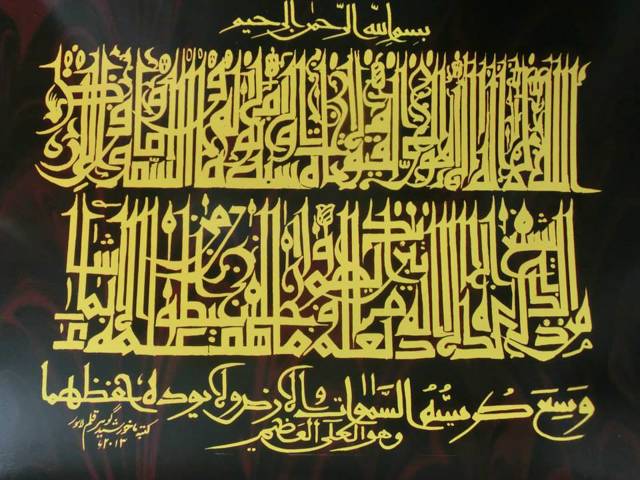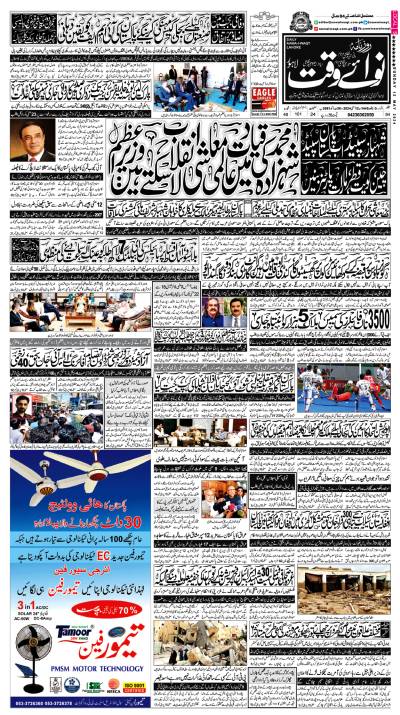Some people call him the man with the golden hand. Whether he writes on the special paper called wasli (paper made by old Mughal technique), tree bark known as Bhuj Putter or on leather God has bestowed him great skill in writing the verses of Holy Quran. For more than four decades Khurshid Gohar Qalam has produced some of the best artworks of calligraphy in the world.
He is the only Pakistani calligrapher whose works are on permanent display in British Museum in London, Ashmolean museum in Oxford and Eastern Art Gallery in Moscow. His calligraphic artworks adorn the palaces of rulers of Saudi Arabia and UAE. Qalam in Urdu means pen. The title of Gohar Qalam was given to him by calligraphy masters Nafees Raqam and Ghulam Nizamuddin.
Qalam works include a copy of Quran placed in the main state mosque know as Faisal Mosque in Islamabad and includes 406 styles of calligraphy. The manuscript weighing 1600 kg is divided into 30 parts, which have been placed in separate showcases. His calligraphy is also displayed at Data Ganj Baksh shrine. His artworks are often presented as gift to visiting heads of states.
“Allah Almighty has blessed me a lot. He has given me international fame and honour that I could not even have imagined when I was young. The art of calligraphy is scared and I thank Allah Almighty for giving me strength to continue to work at this age with accuracy and depth of thought. The number of my students is in thousands. I have transferred all my knowledge and skills to the next generation,” 61-year-old Khurshid Gohar Qalam said while talking to The Nation. He has for the last 17 years been teaching calligraphy at the National College of Arts. He has a studio in Mozang area of Lahore where he works daily from morning to evening.
Qalam has all the top awards of the country including President of Pakistan’s Pride of Performance. He was also awarded highest award from the foreign minister of Japan in 2005. He has to his credit 33 international exhibits at the Metropolitan Museum of Tokyo.
He is very humble and polite and never talks about his achievements. “My real reward comes from the appreciation of people and blessings of Allah Almighty. I believe we should not forget our roots. We should not forget that calligraphy is part of our heritage, which must not only be preserved but should be made to flourish. The government should take steps to promote the art of calligraphy.
“The people at the helm of affairs in government do not understand the importance of calligraphy in the world. Among all arts calligraphy is considered the nucleus of all arts. Many great artists of the world began their carrier as calligraphers and then turned to other art forms.
“Calligraphy is given a lot of importance in other countries like China, South Korea and Japan. They consider it as part of their heritage and culture. In Japan it is compulsory for children in junior school to learn the art of calligraphy. It should be introduced in our public and private sector schools. The Higher Education Commission should take note of the importance of calligraphy and introduce it in colleges and universities,” Qalam said.
Qalam is a man of letters and he loves to read books in his spare time. He has to his credit 18 books. Five of his books have been prescribed by the Higher Education Commission of Pakistan in syllabi for graduation and masters degrees in fine arts.
“I made a 30 episode TV series to explain the history of calligraphy and how it different styles were introduced and by whom. Then I wrote a 16 episode TV play Pukar. It was about the history of Spain and Muslims contribution to art there,” Qalam said.
His son Zahir Khurshid is carrying in his footsteps. “He is a student of visual communication design at the NCA. He has a natural flair for calligraphy. I have not forced him to learn but he does it in spare time. He is learning different styles of calligraphy. It would be a proud moment for me when his first exhibition will be held,” the master calligrapher said.
Qalam is a master of many styles of calligraphy, including Lahori Nastaleeq,Thuluth Kufic, Muhaqiq,Nasakh, tughra,Dewani, Ruqqaa Sumbali, Tajaweedh, Moshahy, Jaleel, Thuluth-e-Kabeer, Narjiss, Ijazaa, Thuluthian, English Gothic. He is also a master of cubist calligraphic art.
After crossing the age of 60 the perfection in his work continues to grow stronger. No doubt he is legend in his own right. n









